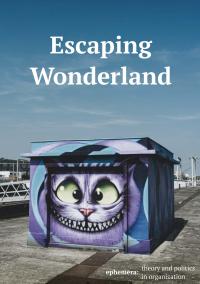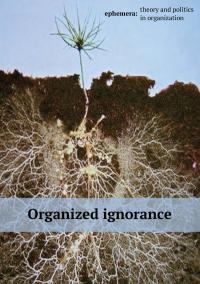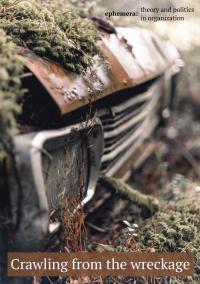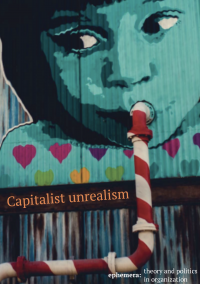Horror Ltd. — Death, fear and other services
| Attachment | Size |
|---|---|
| CfPOrganizinghorror.pdf | 169.77 KB |
In this special issue, we propose to confront the dark underbelly of organizational life, specifically attempting to gain an understanding of the organization as marked by horror (loosely understood as prevalent atmosphere), mobilising fear (understood as technique) and haunted by death (understood as eminent horizon). We propose to address these through three interrelated exploratory avenues.
The first puts into focus organization as, we might hope, an unwitting producer of horror, fear, and space haunted by death. Human subjects are necessary to the material flows of the social machine of organizations (Cooper and Burrell, 1988; Burrell, 1997) and in functioning, organizations subjugate life and produce death (Banerjee, 2008) from the transformative consumption of such flows. Recent well publicised global cases — for instance, the multiple suicides at Foxconn, death by overworking at Toyota, death as a result of privatisation of NHS and even the mass death of non-human species caused by the BP Deepwater Horizon oil spill — illuminate the centrality of death in contemporary organizations. Then organizations will inevitably also die themselves (Bell and Taylor, 2011) and might take others with them to the grave, as was most pointedly demonstrated by the bankruptcies of some major corporations.
Additionally rationality of organizational and administrative processes have previously been theorized as a sort of torture (Cooper and Burrell, 1988; Burrell, 1996; 1997) instilling an element of barbarism or fear in organizations. Indeed, fear is present in organizations, and seen as an emotive inhibitor to productivity (Karasek and Theorell, 1992; Tanner et al., 1989) or something that dispels trust and subverts communication (Galford and Drapeau, 2003); it threatens the order and the rationality of the organization and is to be abjected in favour of kinder emotions, such as love (for instance, Gabriel, 2012). Yet, it persists in organizations, and has even been deployed for its productive capabilities in exploiting and controlling labour relations (Carr, 1988; Gabriel, 1998; Fineman and Sturdy, 1999). All in all, organizations while pursuing some other goals, produce atmospheres of horror, mobilise fear and can leave death as the only solution for many.
The second avenue invites us to ponder: what if the dimension of horrific is not just an unintentional product of management and organizing? We know that historically organizations and management were deployed as legitimate regimes of modernisation, serving as tools of fear, torture and murder (Burrell, 1997; Westwood and Jack, 2008). Bauman’s (1989) account of the Holocaust elucidates such connections by demonstrating the underpinnings of bureaucratic organization in death camps. Management and organizing therefore becomes more than a means to a relatively benign end from management textbooks, but instruments of producing nothing other than horror, death and devastation.
Whilst scholars have provided some analysis of instances where death goes hand in hand with capitalist organization (see Cederström and Fleming, 2012), it appears that the field in general is somewhat unmotivated to engage with death or genocide and the role of organizational projects in supporting death on a mass scale (Stokes and Gabriel, 2010), despite what appears on the face of it a remarkable similarity in how bureaucracy, hierarchical power relations, and even leadership — topics generally maligned in organization studies and especially critical management studies — are prevalent in killing and even fundamental to the execution of genocide (Burrell, 1997; Stokes and Gabriel, 2010; Cunha et al., 2011).
The stark conclusion we draw is that organization theorists and management scholars shy away from the horrific functions of their objects of study; we may also shudder in confronting death as integral part of organizations. Despite this, there are important recent studies of organizations, death, suicide and genocide, that point to the centrality of death within organizational work (for an overview, see Linstead et al., 2014), including even the repression of an organizational death drive (Walter, 2014). Albeit these are few in number and marginal in organization studies. To that end, we echo calls (Stokes and Gabriel, 2010; Cunha et al., 2011; Linstead et al., 2014) for more studies on how organizations often deliberately contribute to death. Thus we propose to make the horrific dimension of organizational life high on the agenda of organization scholarship. In the context of horror, fear is the affective result of confronting the monstrous often coupled with a visceral reaction of revulsion or disgust and is tantamount to an emotional or psychological violation (Clover, 1992; Carroll, 1999; Hills, 2005). As a result, fear no longer arises in the confrontation with work, but may be the intention of the monstrous organization. Even in its very functioning, some go so far as to argue that the terminal result of organizations is not to produce commodities but to exercise violence and fear and produce global dispossession (Banerjee, 2008; Herod et al., 2013). Even deriving profit from such activities (Funnell and Chwastiak, 2015). This suggests that fear is in the very fabric of contemporary organizations, and a necessary part of its functioning and not just an accidental by-product. The task of management and organizing becomes profitable by orchestrating and deploying fear and perpetuating horror.
The absence of fear in organizations doing death’s work is equally worthy of attention. Palliative care and end of life treatment, for instance, is intended to confront death in quiet settings, and to render it not as an object of fear or horror, but as a task carried out by specialist care workers. In short, end of life care work is something ‘meaningful’ (cf. Lips-Wiersma et al., 2009) for management to engage in. However, this can also be approached within a more managerialist tone, viewing care (Witman et al., 2010: 488) and end of life care as something to be delivered within acceptable cost margins (Golant and Sillince, 2007: 1157). What, then, can it mean to organize for a death without fear? Can the horror be truly removed, or does the psychological burden of this special carework create their own emotional spectres that haunt?
Our third avenue opens up death as a broader ontological and epistemological horizon for the study of organizations. By disavowing death and horror, through writing of them as unfortunate collateral outcomes of any worldly activities or by containing them with shifting focus towards coping mechanisms, we paint an unnecessarily distorted picture. If only we mend things a little bit, if only we retain some sanity for a little longer, the horror will vanish. Thereby from the epistemological point of view bringing death back might offer realistic reflections about organizational research. Death becomes an over-arching point – producing research that disavows death is also an ending – to some apocalyptic horizon; it becomes increasingly difficult to sell a brighter future to ourselves and our students, and so one needs to be realistic and prepare for the death of our own scholarship as well. The ontological angle inevitably directs us towards Heidegger’s being-towards-death (cf. Reedy and Learmonth, 2011). For one it insists on factoring in death into understanding of the being of organizations as a gesture of maturity, which breaks with the tradition of distanced positive scholarship prevalent in the area of organization studies.
With this call we propose to focus on understanding how the organization is seen, or understood, as a site of horror. We specifically encourage an exploration into darker areas of organizational functioning where organizational and management scholars’ fear to tread. This includes understanding the role of organizations in producing death and how organizations can produce regimes of fear. Each of these areas are important concerns within society, having drawn the attention of scholars across the social sciences and humanities, but have yet to be given flesh in the pages of organizational and management journals. To that end, we especially invite contributions on the following areas:
- Representations of organizations as sites of horror
- How organizations produce or manage horror, fear and death
- Organizational research in the context of horror, fear and death
- (Self-)Organizing death
The above list is indicative and we welcome submissions drawing from a wider set of issues. We also welcome interdisciplinary papers, empirical or theoretical papers, as long as the theme of organizational horror is addressed.
Deadline for submissions: Thursday 15 March 2018
All contributions should be submitted to the issue editors: Kenneth Weir (khw11[at]le.ac.uk) and Konstantin Stoborod (ks459[at]le.ac.uk). ephemera encourages contributions in a variety of formats including articles, notes, interviews, book reviews, photo essays and other experimental modes of representation. Information about the different types of contributions can be found at: http://www.ephemerajournal.org/how-submit. Submissions to this special issue will undergo a double blind review process. All submissions should follow ephemera’s submissions guidelines, available at: http://www.ephemerajournal.org/how-submit. For further information, please email the issue editors.
References
Banerjee, S.B. (2008) ‘Necrocapitalism’, Organization Studies, 29(12): 1541-1563.
Bauman, Z. (1989) Modernity and the Holocaust, New York: Cornell University Press.
Blazer, A.E. (2002) ‘Chasms of reality, aberrations of identity: defining the postmodern through Bret Easton Ellis's American Psycho’, Americana: The Journal of American Popular Culture (1900-present), Fall 2002 1(2). [http://www.americanpopularculture.com/journal/articles/fall_2002/blazer.htm]
Burrell, G. (1996) ‘Normal science, paradigms, metaphors, discourses and genealogies of analysis’, In S. Clegg, C. Hardy and W. Nord (Eds.), The handbook of organization Studies. London: Sage.
Burrell, G. (1997) Pandemonium: Towards a retro-organization theory, London: Sage.
Carr, A. (1988) ‘Identity, compliance and dissent in organizations: a psychoanalytic perspective’, Organization, 5(1): 81-99.
Carroll, N. (1999) ‘Horror and humor’, Journal of Aesthetics and Art Criticism, 57 (2): 145-160.
Cederström, C. and P. Fleming (2012) Dead man working. London: Zero books.
Clover, C.J. (1992) Men, women and chainsaws: Gender in the modern horror film. Princeton (NJ): Princeton University Press.
Cooper, R. and G. Burrell (1988) ‘Modernism, post modernism and organizational analysis: an introduction’, Organization Studies, 9: 91-112.
Cunha, M. P., A. Rego, and S. Clegg. (2011) ‘Pol Pot, alias brother number one: Leaders as instruments of history’, Management and Organizational History, 6 (3): 268-286.
Fineman, S. and A. Sturdy (1999) ‘The emotions of control: A qualitative exploration of environmental regulation’, Human Relations, 52(5): 631-663.
Funnell, W. and M. Chwastiak. (2015) Accounting at war: The politics of military finance, London: Routledge
Gabriel, Y. (1998) ‘Psychoanalytic contributions to the study of the emotional life of organizations’, Administration and Society, 30(3): 291-314.
Gabriel, Y. (2012) ‘Organizations in a state of darkness: Towards a theory of organizational miasma’, Organization Studies, 33(9): 1137-1152.
Galfrod, R.M. and A.S. Drapeau (2003) ‘The enemies of trust’, Harvard Business Review, 81(2): 88-95.
Golant, B.D., and J.A.A. Sillince (2007) ‘The constitution of organizational legitimacy: A narrative perspective’, Organization Studies, 28(8): 1149-1167.
Herod, A., G. Pickren, A. Rainnie and S. McGrath-Champ (2013) ‘Waste, commodity fetishism and the ongoingness of economic life’, Area, 45(3): 376-382.
Hills, M. (2005) The pleasures of horror. London: Continuum.
Karasek, R. and T. Theorell (1992) Healthy work: Stress, productivity, and the reconstruction of working life. New York: Basic Books.
Linstead, S., G. Maréchal, and R.W. Griffin (2014) ‘Theorizing and researching the dark side of organization’, Organization Studies, 35(2): 165-188.
Lips-Wiersma, M., K. Lund, and C.J. Fornaciari (2009) ‘Theorizing the dark side of the workplace spirituality movement’, Journal of Management Inquiry, 18: 288-300.
Reedy, P. and M. Learmonth (2011) ‘Death and organization: Heidegger's thought on death and life in organizations’, Organization Studies, 32(1): 117-131.
Stokes, P. and Y. Gabriel (2010) ‘Engaging with genocide: The challenge for organization and management studies’, Organization, 17(4): 461-480.
Tanner, J., E. Day, and M. Crask (1989) ‘Protection motivation theory: An extension of fear appeals theory in communication’, Journal of Business Research, 19(4): 267-276.
Walter, T. (2014) ‘Organizations and death: A view from death studies’, Culture and Organization, 20(1): 68-76.
Westwood, R. (2004) ‘Comic relief: Subversion and catharsis in organizational comedic theatre‘, Organization Studies, 25(5): 775-795.
Westwood, R. and G. Jack (2008) ‘The US commercial-military-political complex and the emergence of international business and management studies’, Critical Perspectives on International Business, 4(4): 367-388.
Witman, Y., G.A.C. Smid, P.L. Meurs, and D.L. Willems (2010) 'Doctor in the lead: Balancing between two worlds', Organization, 18(4): 477-495.




